Learn the secret of Mars formation
About 4.6 billion years ago, the planet Mars and the remaining planets in the solar system were formed. However, the precise understanding of how the planets in the solar system are formed remains a controversial topic. Recently, there are two hypotheses that are supposed to have the highest accuracy.
The most widely popular hypothesis is that the core accretion works well in the formation of terrestrial planets like Mars, but there are problems with giant planets. The second hypothesis is that the unstable disk method can explain the formation of giant planets. [Learn about the secret of Mercury formation]
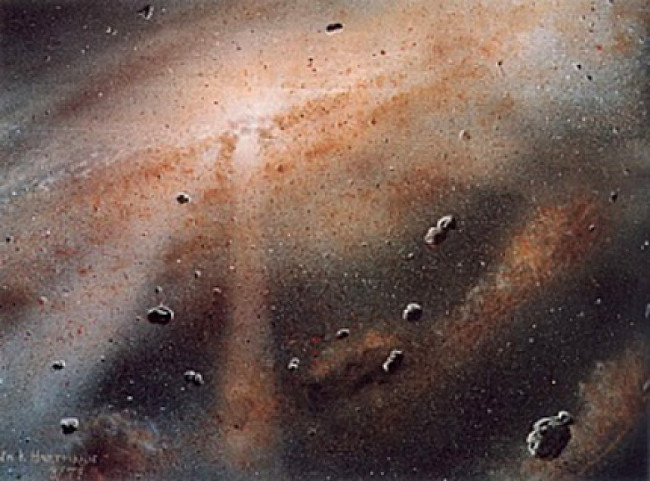 Images of the solar nebula in our solar system, clouds of gas and dust formed by planets.Photo source: author William William Hart Hartmann, Institute of Planetary Sciences in Tucson.
Images of the solar nebula in our solar system, clouds of gas and dust formed by planets.Photo source: author William William Hart Hartmann, Institute of Planetary Sciences in Tucson.
Scientists continue their efforts to study planets within and outside the Solar System to better understand these methods, in the most accurate way.
Core deposition model
The original hypothesis, known as core accretion , is that the solar system begins as a large, wavy cloud with cold air and dust, known as the solar nebula. The nebula is broken by its own gravity and flattened into a rotating disc. The matter is sucked into the center of the disk, forming the Sun.
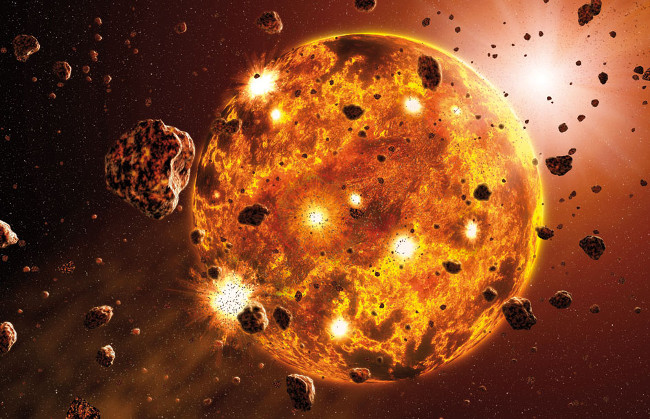
Various small pieces of matter are stuck together to form blocks called planetary objects (planetesimals). Some planetary objects combine to form asteroids, comets, moons and planets. The solar wind - charged particles emitted from the Sun - sweeps away lighter particles like hydrogen and helium, leaving behind all the small rock planets. However, in the outer solar system, the giant gas formation formed mainly of hydrogen and helium gas formed by the weakening of the solar wind.
Perhaps, extraterrestrial observations help determine core accretion as the formation process is affected. Stars contain many " metals " - the term astronomers use for other elements with more hydrogen and more helium - in their cores there are more giant planets than those on planets. I am " poor in metal ". According to NASA, core accretion shows small, rocky worlds more popular than giant gas planets.
Discovered in 2005 about a giant gas planet with a giant core orbiting the sun - like the star HD 149026 is an example of extrasolarity that enhances core accretion cases.
" This is a confirmation of the core accretion hypothesis for planet formation and the evidence that these planets should exist in richness, " Greg Henry said in a press release. Greg Henry - an astronomer at Tennessee State University, in Nashvilli - discovered fuzzy stars .
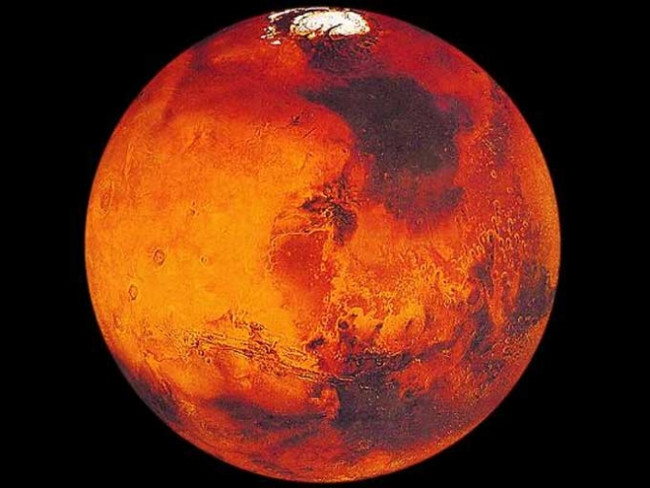
In 2017, the European Space Agency plans to launch the CHARacterising ExOPlanet Satellite (Cheops), - will study different extraterrestrial planets in terms of size from Super Earth to Neptune . Research on distant planets can help determine the formation of planets in the solar system.
" In the core accretion scenario, the core of a planet must reach its maximum mass before it can develop gas during travel. This volume depends on many physical factors, in the most important is the growth rate of planetary microscopic particles, "the Cheops team said.
By studying the physical development of planets, CHEOPS gives insight into how " worlds " develop.
In the late 18th century, Immanuel Kant and Pierre Laplace first recognized the presence of core accretion. The core accretion hypothesis helps explain the formation of planets in the solar system. However, the discovery of " Super Earth " planets revolving around other stars is still a new hypothesis, proposed with the name " unstable disk ".
"Unstable disk" model
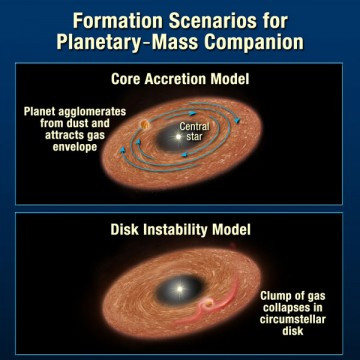
Although the core deposition model works well in Earth planets, giant gas planets will need to grow rapidly to keep a significant amount of lighter gases they are storing. But these models cannot explain the rapid formation. Based on the models, this process takes several million years, longer than the light gases available during the early solar system. At the same time, the core deposition model faces changing problems, just like the planetary planet is capable of spiraling around the Sun in a short period of time.
According to a relatively new hypothesis, " unstable disk ", blocks of dust and gas accumulation are bound together during the early formation of the solar system. Over time, these accumulated masses gradually merge into a giant planet. These planets can form faster than core deposition competitors, sometimes at least a thousand years, allowing them to keep light gases quickly disappearing. In addition, they quickly gain a stabilized orbit to keep them from " walking - dying " to the Sun.
If " unstable disk " affects the formation of planets, then it should produce large numbers of worlds in a large order, says astronomer Paul Wilson. Four giant planets orbiting a considerable distance around the star HD 9799 provide observational evidence for unstable flying saucers. Fomalhaut b, an extraterrestrial planet orbiting the sun for 2000 years, may also be an example of a world formed through unstable disks, although the planet may be ejected when interacting. with the planets around.
Compound Pebble
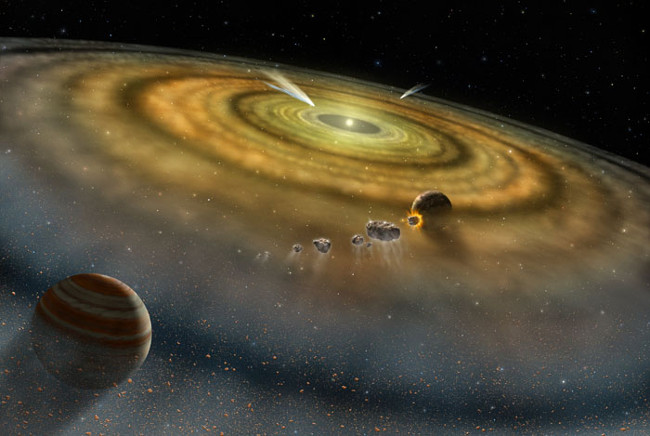
The biggest challenge to core accretion is time - building a massive gas planet quickly to capture the lighter components of the atmosphere. Recently, research on smaller objects, just the size of pebbles, fused together to form giant planets 1000 times faster than previously studied studies.
" This is the first model we know of when starting with the simple structures of the solar nebula, from what the planets formed and ended up being the giant planetary system we see. "research author Harold Levison, an astronomer at the Southwest Research Institute (SwRI) in Colorado, told Space.com in 2015.
In 2012, researchers Michiel Lambrechts and Anders Johansen from Lund University in Sweden proposed that small pebbles, which were once removed, hold important elements to quickly build planets. giant.
" They showed that the remaining stones from this formation process, previously thought to be unimportant, could actually be a huge solution to planet formation ," Levison said.
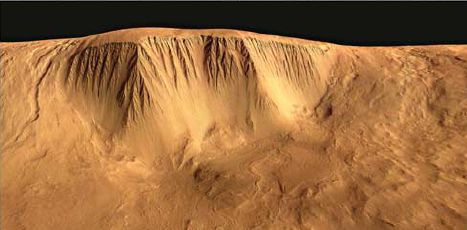 The western image of the young volcano Olympus Mons has a gentle hill and slope with clear canals, some of which can also be created by liquid-water flow and some are clearly seen by rivers ice.
The western image of the young volcano Olympus Mons has a gentle hill and slope with clear canals, some of which can also be created by liquid-water flow and some are clearly seen by rivers ice.
Photo source: Nature / ESA / G. Neukum
Levison and his team built on more accurate research models on how small stones form planets, observed in galaxies today. Meanwhile, the simulation before, both large and medium-sized models, destroyed planets the size of pebbles by a relatively stable ratio. But Levison's simulation shows that larger samples act like " bullying ", " snatching " stones from mass-sized, medium-sized pebbles to grow at a faster rate. .
" Larger specimens now tend to disperse smaller samples than small samples that disperse them, so smaller samples end up dispersing out of the pebble disk", co-authored. research author Katherine Kretke, also from SwRI, answered Space.com. "Basically, older boys often bully smaller boys to be able to eat all the pebbles and continue to grow to form the core of giant planets ."
"Heating" and "cooling"
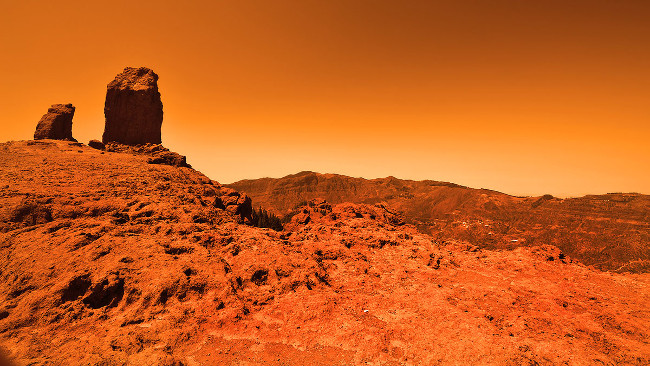
Like all other planets, Mars heats up when formed by energy from collisions. Inside the planet melted and the iron-like particles sank to the center, forming the core. The lighter silicates (silicon anionic compounds) form the mantle crust, the " least dense " silicates that form the shell. Perhaps, Mars had a magnetic field several hundred million years ago, but when this planet Mars " cooled ", this magnetic field also " disappeared ".
The young Mars planet has active volcanoes , spraying lava onto the surface; Water and carbon dioxide enter the atmosphere. However, there is no tectonic activity on Mars, so volcanoes do not move and develop only when erupting.
" It seems that volcanic eruption can also help Mars have a thicker atmosphere. Mars's magnetic field protects the planet from radiation and solar wind. At a higher atmospheric pressure, water will But about 3.5 billion years ago, Mars began to cool, the volcanic eruption became less and less and the magnetic field disappeared as well. blown away and the surface of Mars was bombarded by radiation, "the study showed.
Under these conditions, liquid water cannot exist on the surface of Mars. Studies show that water is trapped underground in both liquid and freezing form; and in ice sheets on the polar ice cap.
As far as we know, life exists when water is in liquid form, so there is a lot of interesting evidence found on Mars.
You should read it
- The answer to the disappearance of water on Mars already exists
- 5 most interesting findings about Red Planet
- 12 interesting facts about Red Planet - Mars may not be known
- Why are microorganisms living 'so tough' on Earth but still hard to survive on Mars
- Interesting facts about Mars may be unknown to you
- Crazy idea: Create an atmosphere for Mars
- Looking back at NASA's Mars exploration process over the past 20 years
- Space Science: The order of 8 (or 9) planets in the Solar System
- How big is the solar system?
- Science test: Potatoes can be grown on Mars
- NASA announces more than 1,000 latest Martian surface images
- NASA 'Mars' helicopter model is almost ready for the journey to conquer Red Planet
May be interested

The new computer model clearly explains the strange trajectory of the Moon

Discover the strange green planet HD 189733b outside the solar system

The biggest super moon in 70 years will appear on November 14

Top 10 interesting facts about the Moon you may not know

20 pictures of super beautiful splendor around the world on November 14

'Aliens will arrive on Earth in September 2017' - Nostradamus' prediction






 Learn about the secret of Mercury formation
Learn about the secret of Mercury formation Mars: Overview of the 4th planet in the solar system
Mars: Overview of the 4th planet in the solar system How does human body change in Mars?
How does human body change in Mars? Looking back at NASA's Mars exploration process over the past 20 years
Looking back at NASA's Mars exploration process over the past 20 years The strangest objects ever taken on Mars surprised many
The strangest objects ever taken on Mars surprised many 5 most interesting findings about Red Planet
5 most interesting findings about Red Planet